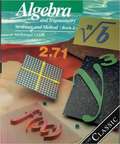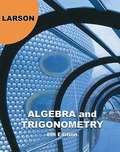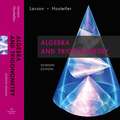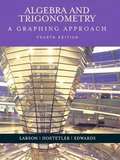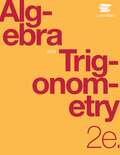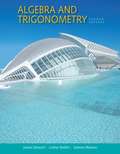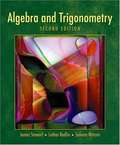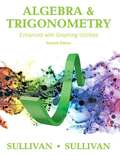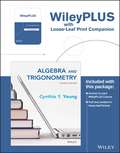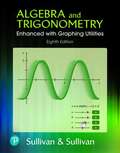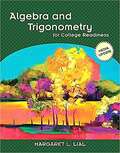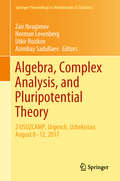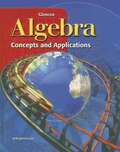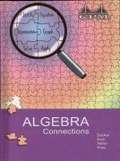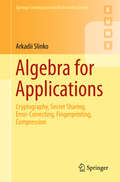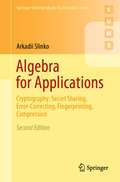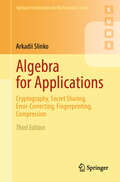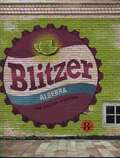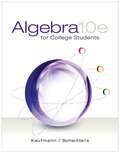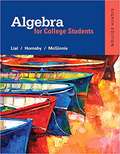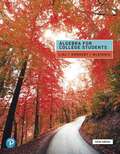- Table View
- List View
Algebra and Trigonometry: Structure and Method
by Richard G. Brown Mary P. Dolciani Robert H. Sorgenfrey Robert B. KaneAlgebra and Trigonometry: Structure and Method (Book 2)
by Richard G. Brown Mary P. Dolciani Robert H. Sorgenfrey Robert B. KaneAn algebra book requires a different type of reading than a novel or a short story. Every sentence in a math book is full of information and logically linked to the surrounding sentences. You should read the sentences carefully and think about their meaning. As you read, remember that algebra builds upon itself; for example, the method of factoring that you'll study on page 188 will be useful to you on page 697. Be sure to read with a pencil in your hand: Do calculations, draw sketches, and take notes.
Algebra And Trigonometry
by Ron LarsonThis market-leading text continues to provide students and instructors with sound, consistently structured explanations of the mathematical concepts. <P><P>Designed for a two-term course, the new Eighth Edition retains the features that have made Algebra and Trigonometry a complete solution for both students and instructors: interesting applications, cutting-edge design, and innovative technology combined with an abundance of carefully written exercises.
Algebra and Trigonometry
by Ron Larson David C. FalvoAs part of the market-leadingGraphing ApproachSeries by Larson, Hostetler, and Edwards,Algebra and Trigonometry: A Graphing Approach,4/e, provides both students and instructors with a sound mathematics course in an approachable, understandable format. The quality and quantity of the exercises, combined with interesting applications, cutting-edge design, and innovative resources, make teaching easier and help students succeed in mathematics. This edition, intended for algebra and trigonometry courses that require the use of a graphing calculator, includes a moderate review of algebra to help students entering the course with weak algebra skills. Accessibility to students is achieved through careful writing and design, including same-page examples and solutions, which maximize the readability of the text. Similarly, side-by-side solutions show algebraic, visual, and numeric representations of the mathematics to support students' various learning styles. TheLibrary of Functionsthread throughout the text provides a definition and list of characteristics for each elementary function and compares newly introduced functions to those already presented to increase students' understanding of these important concepts. Technology Supportnotes provided at point-of-use throughout the text guide students to theTechnology Support Appendix,where they can learn how to use specific graphing calculator features to enhance their understanding of the concepts presented. Houghton Mifflin'sEduspaceonline classroom management tool offers instructors the option to assign homework and tests online, provides tutorial support for students needing additional help, and includes the ability to grade any of these assignments automatically.
Algebra and Trigonometry
by Ron Larson David C. FalvoThis market-leading text continues to provide students and instructors with sound, consistently structured explanations of the mathematical concepts. Designed for a two-term course, the new Eighth Edition retains the features that have made Algebra and Trigonometry a complete solution for both students and instructors: interesting applications, cutting-edge design, and innovative technology combined with an abundance of carefully written exercises.
Algebra and Trigonometry
by Ron Larson Robert Hostetler David C. FalvoThis market-leading text continues to provide students and instructors with sound, consistently structured explanations of the mathematical concepts. Designed for a two-term course, the new Seventh Edition retains the features that have made Algebra and Trigonometry a complete solution for both students and instructors: interesting applications, cutting-edge design, and innovative technology combined with an abundance of carefully written exercises.
Algebra and Trigonometry: A Graphing Approach (4th edition)
by Ron Larson Robert P. Hostetler Bruce H. Edwards David C. FalvoAs part of the market-leading Graphing Approach series by Larson, Hostetler, and Edwards, Algebra and Trigonometry: A Graphing Approach, 4/e, provides both students and instructors with a sound mathematics course in an approachable, understandable format. The quality and quantity of the exercises, combined with interesting applications, cutting-edge design, and innovative resources, make teaching easier and help students succeed in mathematics. This edition, intended for algebra and trigonometry courses that require the use of a graphing calculator, includes a moderate review of algebra to help students entering the course with weak algebra skills.
Algebra and Trigonometry
by OpenStaxAlgebra and Trigonometry 2e provides a comprehensive exploration of mathematical principles and meets scope and sequence requirements for a typical introductory algebra and trigonometry course. The modular approach and the richness of content ensure that the book addresses the needs of a variety of courses. Algebra and Trigonometry 2e offers a wealth of examples with detailed, conceptual explanations, building a strong foundation in the material before asking students to apply what they’ve learned.
Algebra And Trigonometry
by James Stewart Lothar Redlin Saleem WatsonThis bestselling author team explains concepts simply and clearly, without glossing over difficult points. Problem solving and mathematical modeling are introduced early and reinforced throughout, providing students with a solid foundation in the principles of mathematical thinking. Comprehensive and evenly paced, the book provides complete coverage of the function concept, and integrates a significant amount of graphing calculator material to help students develop insight into mathematical ideas. The authors' attention to detail and clarity--the same as found in James Stewart's market-leading Calculus book--is what makes this book the market leader.
Algebra and Trigonometry
by M. SullivanPrepare, Practice, Review The Sullivan’s time-tested approach focuses students on the fundamental skills they need for the course: preparing for class, practicing with homework, and reviewing the concepts. The Enhanced with Graphing Utilities Series has evolved to meet today’s course needs by integrating the usage of graphing calculators, active-learning, and technology in new ways to help students be successful in their course, as well as in their future endeavors. In the Seventh Edition, there are several new features that appear in both the text and MyMathLab. Retain Your Knowledge problems offer the type of “final exam material” that students can use to maintain their skills throughout each chapter.
Algebra and Trigonometry
by Cynthia YoungCynthis Young's Algebra & Trigonometry, Fourth Edition will allow students to take the guesswork out of studying by providing them with a clear roadmap: what to do, how to do it, and whether they did it right, while seamlessly integrating to Young's learning content. Algebra & Trigonometry, Fourth Edition is written in a clear, single voice that speaks to students and mirrors how instructors communicate in lecture. Young's hallmark pedagogy enables students to become independent, successful learners. Varied exercise types and modeling projects keep the learning fresh and motivating. Algebra & Trigonometry 4e continues Young's tradition of fostering a love for succeeding in mathematics.
Algebra And Trigonometry Enhanced With Graphing Utilities
by Michael SullivanThe proven approach of Michael Sullivan and Michael Sullivan III focuses you on the fundamental skills needed for the algebra and trigonometry course: prepare for class, practice with homework, and review the concepts. Part of the Enhanced with Graphing Utilities Series, Algebra and Trigonometry Enhanced with Graphing Utilities fully integrates graphing utilities into topics, allowing you to explore mathematical concepts and encounter ideas usually studied in later courses. Many examples show solutions using algebra side by side with graphing techniques. In the 8th Edition, all exercises and examples in the text have been reviewed and updated as needed, and the authors have added new problem-solving and review features.
Algebra And Trigonometry For College Readiness
by Margaret L. Lial John HornsbyAlgebra and Trigonometry for College Readiness
Algebra, Complex Analysis, and Pluripotential Theory: 2 USUZCAMP, Urgench, Uzbekistan, August 8–12, 2017 (Springer Proceedings in Mathematics & Statistics #264)
by Zair Ibragimov Norman Levenberg Utkir Rozikov Azimbay SadullaevThis book features papers presented during a special session on algebra, functional analysis, complex analysis, and pluripotential theory. Research articles focus on topics such as slow convergence, spectral expansion, holomorphic extension, m-subharmonic functions, pseudo-Galilean group, involutive algebra, Log-integrable measurable functions, Gibbs measures, harmonic and analytic functions, local automorphisms, Lie algebras, and Leibniz algebras. Many of the papers address the theory of harmonic functions, and the book includes a number of extensive survey papers. Graduate and researchers interested in functional analysis, complex analysis, operator algebras and non-associative algebras will find this book relevant to their studies. The special session was part of the second USA-Uzbekistan Conference on Analysis and Mathematical Physics held on August 8-12, 2017 at Urgench State University (Uzbekistan). The conference encouraged communication and future collaboration among U.S. mathematicians and their counterparts in Uzbekistan and other countries. Main themes included algebra and functional analysis, dynamical systems, mathematical physics and partial differential equations, probability theory and mathematical statistics, and pluripotential theory. A number of significant, recently established results were disseminated at the conference’s scheduled plenary talks, while invited talks presented a broad spectrum of findings in several sessions. Based on a different session from the conference, Differential Equations and Dynamical Systems is also published in the Springer Proceedings in Mathematics & Statistics Series.
Algebra Concepts and Applications
by Glencoe Mcgraw-HillAlgebra: Concepts and Applications is designed to help you learn algebra and apply it to the real world. Throughout the text, you will be given opportunities to make connections from concrete models to abstract concepts. The real-world photographs and realistic data will help you see algebra in your world. You will also have plenty of opportunities to review and use arithmetic and geometry concepts as you study algebra.
Algebra Connections, Version 3.1
by Leslie Dietiker Evra Baldinger Kevin CoffeyNIMAC-sourced textbook
Algebra for Applications: Cryptography, Secret Sharing, Error-Correcting, Fingerprinting, Compression (Springer Undergraduate Mathematics Series)
by Arkadii SlinkoThis book examines the relationship between mathematics and data in the modern world. Indeed, modern societies are awash with data which must be manipulated in many different ways: encrypted, compressed, shared between users in a prescribed manner, protected from an unauthorised access and transmitted over unreliable channels. All of these operations can be understood only by a person with knowledge of basics in algebra and number theory. This book provides the necessary background in arithmetic, polynomials, groups, fields and elliptic curves that is sufficient to understand such real-life applications as cryptography, secret sharing, error-correcting, fingerprinting and compression of information. It is the first to cover many recent developments in these topics. Based on a lecture course given to third-year undergraduates, it is self-contained with numerous worked examples and exercises provided to test understanding. It can additionally be used for self-study.
Algebra for Applications: Cryptography, Secret Sharing, Error-Correcting, Fingerprinting, Compression (Springer Undergraduate Mathematics Series)
by Arkadii SlinkoModern societies are awash with data that needs to be manipulated in many different ways: encrypted, compressed, shared between users in a prescribed manner, protected from unauthorised access, and transmitted over unreliable channels. All of these operations are based on algebra and number theory and can only be properly understood with a good knowledge of these fields. This textbook provides the mathematical tools and applies them to study key aspects of data transmission such as encryption and compression.Designed for an undergraduate lecture course, this textbook provides all of the background in arithmetic, polynomials, groups, fields, and elliptic curves that is required to understand real-life applications such as cryptography, secret sharing, error-correcting, fingerprinting, and compression of information. It explains in detail how these applications really work. The book uses the free GAP computational package, allowing the reader to develop intuition about computationally hard problems and giving insights into how computational complexity can be used to protect the integrity of data.The first undergraduate textbook to cover such a wide range of applications, including some recent developments, this second edition has been thoroughly revised with the addition of new topics and exercises. Based on a one semester lecture course given to third year undergraduates, it is primarily intended for use as a textbook, while numerous worked examples and solved exercises also make it suitable for self-study.
Algebra for Applications: Cryptography, Secret Sharing, Error-Correcting, Fingerprinting, Compression (Springer Undergraduate Mathematics Series)
by Arkadii SlinkoThis textbook provides mathematical tools and applies them to study key aspects of data transmission such as encryption and compression. Modern societies are awash with data that needs to be manipulated in many ways: encrypted, compressed, shared between users in a prescribed manner, protected from unauthorized access, and transmitted over unreliable channels. All of these operations are based on algebra and number theory. This textbook covers background topics in arithmetic, polynomials, groups, fields, and elliptic curves required for real-life applications like cryptography, secret sharing, error-correcting, fingerprinting, and compression of information. The book illustrates the work of these applications using the free GAP computational package. It uses this package to help readers understand computationally hard problems and provide insights into protecting data integrity. This textbook covers a wide range of applications including recent developments, primarily intended for use as a textbook, with numerous worked examples and solved exercises suitable for self-study. This edition has been thoroughly revised with new topics and exercises, introducing hash functions for properly describing digital signatures, blockchains, and digital currencies in the latest version.
Algebra for College Students
by Robert BlitzerGets them engaged. Keeps them engaged. Bob Blitzer’s use of realistic applications instantly piques students’ curiosity about the presence of mathematical concepts in the world around them. These applications are apparent throughout the entire program–from his relatable examples, friendly writing style, and thought-provoking features in the textbook, to the enhanced digital resources in the MyMathLab course. Blitzer pulls from topics that are relevant to college students, often from pop culture and everyday life, to ensure that students will actually use their learning resources to achieve success. With an expansion of the series to now include a Developmental Math “all-in-one” text (with content spanning prealgebra through intermediate algebra), and with an enhanced media program accompanying this revision, developmental students at all levels will see how math applies to their daily lives and culture.
Algebra for College Students
by Jerome E. Kaufmann Karen L. SchwittersKaufmann and Schwitters have built this text's reputation on clear and concise exposition, numerous examples, and plentiful problem sets. <p><p>This traditional text consistently reinforces the following common thread: learn a skill; practice the skill to help solve equations; and then apply what you have learned to solve application problems. This simple, straightforward approach has helped many students grasp and apply fundamental problem solving skills necessary for future mathematics courses. Algebraic ideas are developed in a logical sequence, and in an easy-to-read manner, without excessive vocabulary and formalism. <p><p>The open and uncluttered design helps keep students focused on the concepts while minimizing distractions. Problems and examples reference a broad range of topics, as well as career areas such as electronics, mechanics, and health, showing students that mathematics is part of everyday life. The text's resource package anchored by Enhanced WebAssign, an online homework management tool saves instructors time while also providing additional help and skill-building practice for students outside of class.
Algebra For College Students
by Margaret Lial John Hornsby Terry McGinnisThe Lial Developmental Algebra Series uses a teacherly writing style and a careful blend of skills development and conceptual questions to meet the unique needs of the developmental math student. The author team takes advantage of experiences in the classroom and an editing eye to offer one of the most well-rounded series available, written with the developmental learner in mind. In this revision, the team retains their hallmark writing style, and provides new features and resources to optimize student preparedness and conceptual understanding. The Lial program provides students with the perfect balance of skills and concepts for a student-friendly approach to math.
Algebra for College Students
by Margaret Lial John Hornsby Terry McGinnisFor courses in Algebra for College Students (Intermediate Algebra with a small amount of College Algebra). Balancing skills and concepts The Lial Developmental Algebra Series uses a teacherly writing style and a careful blend of skills development and conceptual questions to meet the unique needs of the developmental math student. The author team takes advantage of experiences in the classroom and an editing eye to offer one of the most well-rounded series available, written with the developmental learner in mind. In this revision, the team retains their hallmark writing style, and provides new features and resources to optimize student preparedness and conceptual understanding. The Lial program provides students with the perfect balance of skills and concepts for a student-friendly approach to math.

